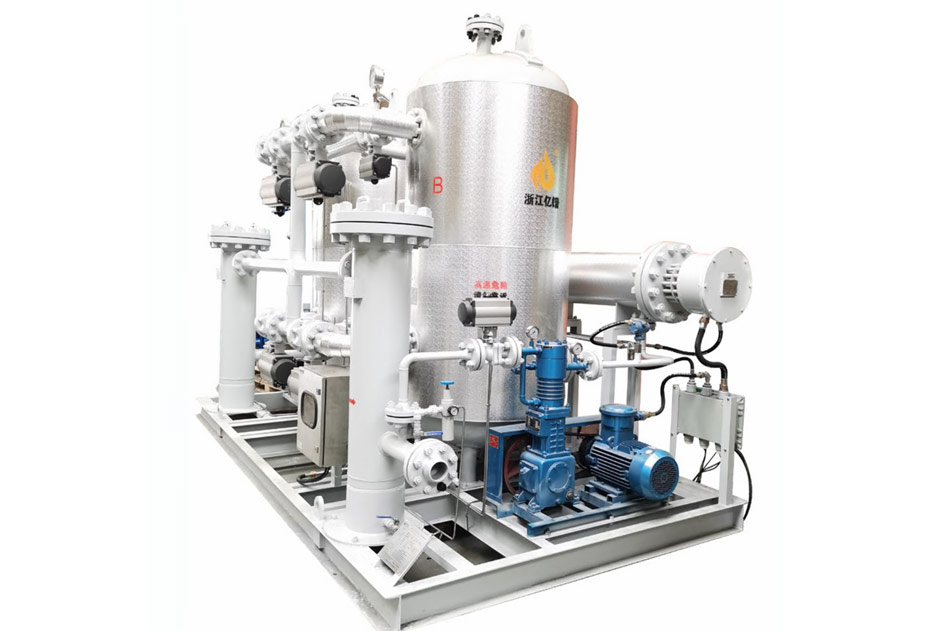Natural Gas Dehydration Solutions
Industry Pain Points
System Overview
Yipu Natural Gas Dehydration System solves the purification challenges of high-sulfur and high-humidity natural gas through a three-stage synergistic technology of “mechanical separation + condensation + adsorption”. Its core values include:
- Long-term Reliability: 8-year maintenance-free design, adaptable to -30℃~50℃ environments.
- Fast Return on Investment: Payback period of 1.5-3 years (calculated at a gas price of 2 RMB/m³).
- Green Transition: Helps customers gain additional benefits through CCER carbon trading.
- Technological Evolution: Launched the AI intelligent dew point prediction system in 2024, which adjusts operating parameters 24 hours in advance, reducing energy consumption by another 15%.
Solution Approach
Yipu Natural Gas Dehydration System Solution
| Module | Function |
|---|---|
| Pretreatment Unit | Filters particles (≤1μm) and removes H₂S (activated carbon/amine liquid scrubbing optional) |
| Condensation Dehydration Module | High-efficiency heat exchanger + refrigerant circulation system, rapidly reducing dew point to -10℃ |
| Adsorption Drying Tower | Dual-tower design; molecular sieves resist sulfur poisoning and support automatic switching |
| VOCs Recovery | Recovers ≥90% of light hydrocarbons (C3+) from condensate, improving economy |
| Intelligent Control System | PLC real-time monitors pressure and dew point, and links with compressors/tanks |
| Zero-Discharge Design | Wastewater meets standards after treatment (COD ≤50mg/L); waste gas complies with GB 39728-2020 |
Applicable Scenarios:
- Shale gas/conventional natural gas field gathering stations
- Pretreatment before LNG liquefaction
- Pressure regulation and dehydration at urban gas gate stations
- Purification of feed gas for chemical industry
Technical Principles
Yipu Natural Gas Dehydration System adopts multi-stage purification technology:
- Mechanical Separation (First Stage): Cyclone separators remove liquid water droplets and solid particles (efficiency ≥95%).
- Condensation Dehydration (Second Stage): Plate-fin heat exchangers use external refrigerants (e.g., propane) to cool natural gas from 40℃ to 5-10℃, condensing free water (dew point reduced to -10℃).
- Adsorption Drying (Third Stage): Molecular sieves (Type 4A or 13X) deeply adsorb residual moisture under high pressure (4-8MPa), achieving a dew point of -70℃ (moisture ≤1ppm).
- Intelligent Regeneration (Optional): Uses hot nitrogen purging for regeneration (180-220℃), extending the service life of molecular sieves to over 8 years.
Core Advantage
| Advantage | Details |
|---|---|
| Customized on Demand | Meets special working conditions; provides professional non-standard customization |
| Low Cost | Adopts cyclic regeneration process; significantly reduces operating costs |
| High Stability | Dual-tower structure with small pressure fluctuation; low noise and continuous gas supply |
| Fully Automatic Operation | Easy to operate, reducing labor input; improves efficiency |
| High Safety | Presets multi-level safety protection measures; supports automatic alarm |
| Low Failure Rate | Maintains low failure rate after 10,000 hours; high durability with almost no maintenance required |
Technical Strength
Leading Adsorption Dehydration Technology
Uses high-performance molecular sieve adsorbents with high water absorption capacity and resistance to corrosion by acidic gases (H₂S/CO₂), ensuring deep dehydration with a dew point ≤-70℃.
The original hot nitrogen regeneration process reduces energy consumption by 30% compared with traditional electric heating regeneration, and integrates a waste heat recovery system to significantly improve energy efficiency.
Modular and Customized Design Capability
Core equipment adopts modular prefabrication, supporting rapid deployment (installation cycle shortened by 50%) and adapting to diverse scenarios such as offshore platforms, onshore gas fields, and LNG pretreatment.
Can customize single-tower, dual-tower, or multi-tower parallel systems according to customer needs, with a treatment capacity ranging from 10,000 to 1,000,000 Nm³/d, flexibly matching gas fields of different scales.
Intelligent Control and Remote Operation & Maintenance
Equipped with a PLC+IoT intelligent control system, it real-time monitors key parameters such as pressure, temperature, and dew point, supporting fault early warning and automatic adjustment.
Through cloud big data analysis, it optimizes the adsorption-regeneration cycle, extends the service life of molecular sieves, and reduces operation & maintenance costs by 10%-15%.
Energy-Saving and Environmental Protection Technology
Features zero-emission design for regeneration exhaust gas, complying with environmental standards such as EU CE and US EPA.
Energy consumption is 25%-40% lower than that of traditional triethylene glycol (TEG) dehydration systems, helping customers achieve carbon emission reduction goals.
Long-Cycle Operation Reliability
Molecular sieves adopt anti-pulverization coating technology, with a service life of over 5 years, reducing replacement frequency.
Key components (e.g., valves, instruments) are selected from international first-tier brands (e.g., Siemens, Emerson), with a Mean Time Between Failures (MTBF) of over 100,000 hours.
Strong R&D and Engineering Experience
Possesses more than 19 patents and software copyrights in dehydration technology; the R&D team is led by doctors and has in-depth cooperation with universities and colleges.
Has over 1,000 successful cases worldwide, covering extreme working conditions such as high-sulfur gas fields in the Middle East and low-temperature environments in the Arctic.
Product Advantage Comparison
| Indicator | Yipu System | Traditional Refrigeration Dehydration | Chemical Desiccant |
|---|---|---|---|
| Dew Point | -70℃ (customizable to -100℃) | -40℃ (requires deep regeneration) | -20℃ (limited by ambient temperature) |
| Energy Consumption | 0.05kWh/m³ natural gas | 0.15kWh/m³ natural gas | 0.1kWh/m³ natural gas |
| Methane Loss | ≤0.1% | ≥1% (carried by TEG) | ≤0.5% |
| Operation & Maintenance Cost | <0.02 RMB/m³ natural gas | 0.08 RMB/m³ (TEG replacement) | 0.05 RMB/m³ (mainly electricity cost) |
| Explosion-Proof Certification | Ex dⅡCT4 (full series) | Partial explosion-proof | Not applicable |
| Environmental Friendliness | No chemicals, no VOCs emission | TEG degradation produces benzene-based pollutants | Potential refrigerant leakage risk |
Typical Case
Project Name: A Shale Gas Field Dehydration Station
Treatment Capacity: 500,000 m³/day (CH₄ content 92%, H₂S 200ppm)
Dehydration Effect: Dew point reduced from +30℃ to -60℃
Economic Benefits:
- Reduces pipeline corrosion maintenance costs by 3 million RMB/year
- Increases annual income by 5 million RMB through light hydrocarbon recoveryCarbon Emission Reduction: Reduces annual CO₂ emissions by 25,000 tons (equivalent to planting 130,000 trees)

